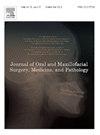Open reduction internal fixation versus closed reduction for the management of mandibular intra-capsular fractures in adult patients: A systematic review and meta-analysis
IF 0.4
Q4 DENTISTRY, ORAL SURGERY & MEDICINE
Journal of Oral and Maxillofacial Surgery Medicine and Pathology
Pub Date : 2024-08-30
DOI:10.1016/j.ajoms.2024.08.018
引用次数: 0
Abstract
Purpose
The management of mandibular condylar head/intra-capsular fractures is a controversial subject. Many centres still prescribe closed/ conservative management of this fracture based upon reasonably good functional rehabilitation and fear of surgical complications. The study aims to generate evidence for the selection of the best treatment (open reduction internal fixation, or closed reduction).
Material and methods
A systematic review of the literature was performed by searching four electronic databases. The protocol was registered in Prospero (CRD42022365919). Using well-defined PICOS criteria, all randomised and non-randomised studies comparing Open reduction internal fixation to a closed reduction of mandible condylar head fracture were included in the study. Eight were selected for final data analysis. The two treatment methods were compared using post-treatment TMJ dysfunction, malocclusion, facial nerve weakness and condylar resorption as outcomes. The statistical analysis was done using Revman 5.4 and MedCalc software.
Results
The meta-analysis results suggested better clinical TMJ function and less malocclusion with open reduction. Better mouth opening associated with closed reduction group. The proportional meta-analysis revealed a 3 % incidence of temporary facial nerve weakness and 47 % condylar resorption associated with open reduction internal fixation.
Conclusion
Open reduction internal fixation of mandible condylar head/intra-capsular fractures are associated with less clinical TMJ dysfunction and malocclusion than the closed reduction/conservative treatment.
求助全文
约1分钟内获得全文
求助全文
来源期刊

Journal of Oral and Maxillofacial Surgery Medicine and Pathology
DENTISTRY, ORAL SURGERY & MEDICINE-
CiteScore
0.80
自引率
0.00%
发文量
129
审稿时长
83 days
 求助内容:
求助内容: 应助结果提醒方式:
应助结果提醒方式:


